About Me
Michael Zucchi
B.E. (Comp. Sys. Eng.)
also known as Zed
to his mates & enemies!
< notzed at gmail >
< fosstodon.org/@notzed >

Hot Sauce #2 - Sweet Arson
As it turns out it was a rainy day and I thought the fresh habaneros either needed to be used or frozen so I made another sauce today as well.
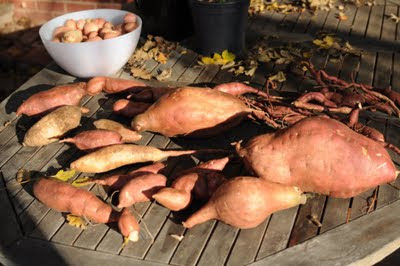
The week previously I had excavated a patch of sweet potatoes and ended up with a reasonable haul (the largest in the photo is 2.4kg) ... and I had the idea of using the sweet potato as the base for this sauce. And this time I thought i'd try a warming mix of herbs to compliment it. I'm really quite pleased with this one - it has quite an interesting and pleasant flavour and will leave your lips burning from even quite a small amount.
Ingredients
| 450g |
Roasted sweet potato (2-3 average tubers). |
| 12 |
Cayesan Chillies, roasted. |
| 12 |
Habaneros, roasted. |
| 150ml |
Grapeseed oil. |
| 1 |
Diced onion. |
|
Dry Spices
|
| 2 tsp |
Coriander seed. |
| 1 tsp |
Cardomon seed. |
| 1 tsp |
Black peppercorns. |
| 1 tsp |
Whole allspice. |
| 2 |
Cloves. |
| 1 tsp |
Fennel seed. |
|
Liquids
|
| 2 cups |
Malt vinegar. |
| 1 1/2 cup |
Water. |
| 1 tsp |
Citric Acid. |
| 1 tsp |
Salt |
| 1 tsp |
MSG |
Method
Place the sweet potato whole and un-peeled into a roasting tray and roast until done - about an hour. Place the chillies on another tray and roast until they start to collapse - about 20 minutes. Remove the potatoes from the oven and let them cool to a suitable temperature for handling and peel the skins off (perhaps sweating them under foil will help).
Meanwhile, place the oil and onion in a medium sized saucepan and cook slowly on low heat - so they become translucent but do not brown.
Take the dry seeds and toast lightly in a dry pan for a few minutes. Use a medium heat and constantly move them so they do not burn. Transfer the seeds to a mortar and pestle and pound to a fine dust.
Add the dry spices to the onions and cook for a couple of minutes.
Add the roasted chillies and sweet potato and mash them together.
Add all of the liquid before it starts to burn, together with the remaining ingredients and simmer for at least 30 minutes on a very low heat.
Use a stick blender to thoroughly blend everything into as fine a liquid as it's capable of (i'm using a Tiffany hand-me-down and it struggles but works).
Bottle.
Results
This tastes really nice so far. Very subtle, slightly sweet and nutty flavour with a lip-burning kick to follow up which seems to multiply with every subsequent taste.
I didn't think it was going to end up hot enough after adding the liquid I needed to make it thin enough, so I threw in another half-dozen chopped habaneros when it was nearly done, cooked them for a while and re-blended. This might be the last hot sauce I make for a while too, so I wanted to make sure it counted!
I'd probably rate this 7.5 out of 10 for heat.
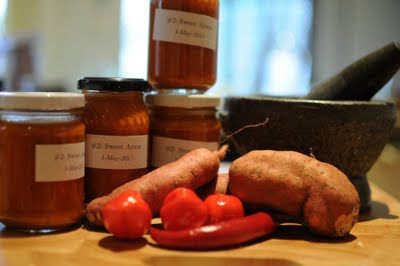 Update So 6 months on, this is definitely my favourite sauce. I think it could use a bit more heat but the flavour goes with lots of things - i sometimes use it instead of butter on sandwiches, for dipping chips (it gets hot!), or to add a pleasant kick to pasta, steak, or a snag. Please comment if you give it a go ...
Update So 6 months on, this is definitely my favourite sauce. I think it could use a bit more heat but the flavour goes with lots of things - i sometimes use it instead of butter on sandwiches, for dipping chips (it gets hot!), or to add a pleasant kick to pasta, steak, or a snag. Please comment if you give it a go ...
Hot Sauce #1 - Toxic Lime
Back with another sauce - this time I thought i'd try something of a Thai theme: lime, kaffier lime, lemongrass, and fresh coriander. I just grabbed a few things from the garden and the pantry that seemed to match and came up with my second sauce, Sauce #1 - Toxic Lime.
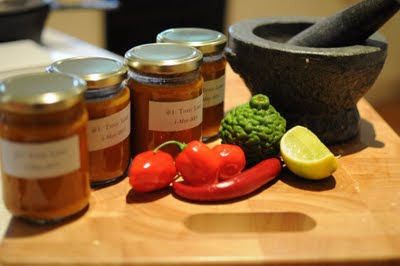
Ingredients
| 350g |
Apples, cored. |
| 60g |
Fresh coriander, including root and stem. |
| 70g |
Fresh lemongrass. |
| 40g |
Fresh ginger. |
| 12g |
Fresh lemon basil leaves. |
| 2 |
Kaffir lime leaf. |
| 1 |
Kaffir lime zest. |
| 2 |
Limes, juice and zest. |
| 200g |
Cayesan chillies (large fleshy chillies) |
| 100g |
Habaneros (about 15) |
| 1/2 cup |
Malt vinegar. |
| 30g |
Palm sugar. |
| 1/2 cup |
Cane Sugar. |
| 1 cup |
Water. |
| 1 tsp |
Citric Acid. |
| 2 tbl |
Mushroom soy sauce (Happy Boy Brand) |
| 100ml |
Olive oil. |
Method
Cut the ginger, lemongrass and lime leaf into fine slices and then put into a food processor and process until finely chopped. Add all of the other fresh ingredients (everything until and including the chillies) and blend thoroughly into a fine paste.
Place into a medium sized saucepan on a low heat and add the liquids and bring to a slow simmer.
Stir in the sugar and simmer everything slowly 'until done' - 30+ minutes.
Use a stick blender to liquefy everything together as much as possible.
Bottle.
Results
This has a slightly strange flavour - despite lime and chilli seeming a good match I've never really found something where it truly 'worked'. Perhaps the kaffier lime zest is a little overpowering, as is the coriander. I will have to leave it for a bit and try it with some suitable food (might go well with pork?).
It definitely has a lime flavour to it though, which is what I was trying to achieve so at this point i'd call it a success. And it smells wonderful. It's probably about a 7 out of 10 for heat as with the previous recipe.
Simple padding trick
For a few algorithms I have, I end up with data which is 32 elements wide operated on by 16x16 threads. This ends up with 100% local memory contention if mapped directly to the local memory since every 16th thread aliases to the same bank.
Although this can be addressed with a 16 word padding this is wasteful of precious local memory which might mean the code can't run in parallel to the extent it might otherwise, or simply cannot fit.
A simple trick which still keeps the addressing quite simple is to shift every odd line to the second half of the data which is then offset by 16 words. In effect bit 0 of the y address is shifted to the top of the addressing index, with an offset.
For example, if a kernel is working on a 16x16 region of memory but requires some data either side of the target tile, it might do something like:
local float ldata[32*16];
int lx = get_local_id(0);
int ly = get_local_id(1);
int i = lx + ly * 32;
// load data
ldata[i] = ..read data block 8 to the left ...;
ldata[i+16] = ..read data 8 to the right...;
barrier(CLK_LOCAL_MEM_FENCE);
// work using i+8 as the centre pixel for this thread
By only changing the calculation of i and padding the storage with only 16 words, the contention is easily removed without changing any other code:
local float ldata[32*16+16];
...
int i = lx + ( ly >> 1 ) * 32 + (32*8+16)*(y & 1);
...
Assuming one is only working in the X direction, for Y the addressing is slightly more complex of course. But this could come at no extra run-time cost once the loops are unwound.
Transpose Is Your Friend
With graphics programming a lot of algorithms can be split into separate X and Y passes. This generally works particularly well in the X case but in Y you can hit issues with memory (or processor) locality which can have a big impact on the algorithm.
But the GPU texture cache is block oriented rather than line oriented so both X and Y oriented algorithms can be implemented equally (in)efficiently if you store data in images. However, once in local memory you're effectively back to line-oriented access ... (if you want to preserve your sanity whilst working out the memory addressing to efficiently access the banked memory).
The trick is just to transpose the data on read and write, and always work in the X direction locally. It also means the X and Y working code is often identical. This can be done just within the local work-group, but for 2D workgroups one has the added complication that work units are allocated in row-major order, i.e. in X first.
The simple solution is just to transpose the global X and Y work-size as well, and simply swap the result of get_global_id(0) and get_global_id(1) when reading or writing the images.
Parallel Prefix Sum
14/9/11: added a further paragraph on additional thoughts
Since coming across the parallel prefix sum a couple of weeks ago, a lot of things I need to solve seem to fall into the class of problems it is suited for within OpenCL on GPU platforms. However after a lot of trial and error and experimentation i've found it is usually just slower - sometimes by quite a margin.
In short, it takes advantage of the very high speed local memory ('LS') and parallelism to compute a commutative result from every element to every previous element in log2(n/2) steps.
But with GPU's there are a couple of problems with it:
- Even in the ideal case many of the threads are computing redundant data or not operating (depending how one chooses to implement it).
- A synchronisation step is required after every single operation - which is usually something trivially simple.
The first leads to an over-commitment of threading resources which impacts the scalability as the overall job size increases. And the second leads to very inefficient scheduling even on simple tasks, and a much heavier 'inner loop'.
For example, I implemented a 5x5 maximum operation (for non-maximum suppression peak detection) using a separate X and Y operation (I realise a 5-tap test doesn't really exercise the log2(N) nature of the algorithm much, but more on that later).
My first implementation uses a 16x16 workgroup size (after much experimentation this seems to be the generally best workgroup size for operating on images on my hardware - it leads to an occupancy of 1 and seems to be a good fit for the texture cache configuration). Each local workgroup reads a 16x16 area into LS and then 16 threads work together on each row of result. It only does a couple of 'prefix sum' steps because I only need the result from 4 samples, and I do the last one manually. I use the trick of offsetting the starting point so no thread requires any conditional execution. Finally, it only produces 12 valid results for the 16 inputs since you need overlap.
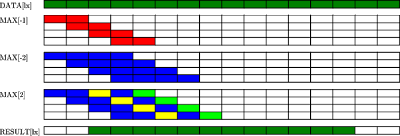
Figure 1: Steps taken for parallel maximum calculation. Only the workings of 4 of the 16 threads are shown.
Because it only generates 12 results it needs to be run 16/12 times the width of the image. This runs in about 65uS on the test data set.
Then I tried a version which reads 2x 16x16 blocks into memory so it can produce all 16 results in one go - unfortunately i've lost the timings and I can't be bothered to re-run it, but i'm fairly confident it wasn't terribly impressive.
Finally I implemented a very simple version which just reads in 2 16x16 blocks into local memory, and then does the operation on the 2 pixels before and 2 pixels after the current location (i.e. an unrolled loop). This was somewhat quicker - 48uS, or about 25% faster.
I didn't bother trying it for the parallel sum case, but I also tried larger window sizes for the simple version - and even at 9 it is still 20% faster than the 5X case for the parallel sum version. And this is for the single channel case - for a 4 channel image you have a 4x LS load, which is not required when it is calculated in registers.
Intuition would tell you that increasing the data-size will eventually lead to a case where it out-performs the simple cases. But the wider the data being calculated the more threads you require and this reduces the opportunity for hiding latencies by letting the GPU schedule independent workgroups. The local store can also be a factor since it too can limit how wide you can go.
I also applied it to (larger) problems where you're only interested in the final result. Because branching is expensive it seems on paper that it doesn't matter if you generate many redundant results since the overall number of steps is much lower - e.g. a 16x16 summation only takes 7 steps rather than 256. Although in reality you break it up into 16 strips 1xwide so it's only 32 steps (16 lots of 16 plus 1 of 16). And it only takes 16 threads rather than 256, so you can execute 16x as many at once for a given number of threads. And you don't need any local store.
I found in all cases it was (sometimes much) faster to split it into 16x1 loops which operate on 16 data items, and then have a single thread complete the partial sums.
And finally the one case where it seemed to have traction - calculating an integral image where every pixel has it's value added to every pixel to the right/below it - did seem faster than another implementation I had. But that initial implementation was before I had discovered other performance improvements so I suspect I could probably do better if i had another go. To satisfy my curiosity I just tried implementing part of it using a looping implementation and with little effort managed to beat or at least equal the prefix-sum version. Incidentally both require splitting the problem into smaller parts and then a final step to 'fix' the integral image - for the parallel prefix sum version you run out of local store or threads, and in both cases you need the parallelism to help improve the GPU efficiency.
Further Thoughts 14/9/11
Since writing this a lot more water has flowed under the bridge and I have a few more thoughts to add.
Having a smaller rather than larger work-size is important as I alluded to above: but larger problems can be made smaller by storing intermediate values in registers and then only sharing the work to reduce a smaller-multiple of the dataset. e.g. storing 4 registers locally allows 4x as much data to be 'processed' using the same amount of shared-work (and shared memory too) - which is the expensive stuff.
Since I was sticking to spec I have never tried removing the barriers and relying on the hardware's behaviour. So I don't know how much difference this makes: the technique in the paragraph above is even more useful then, if you can reduce the problem to the 64 elements required to benefit from the hardware characteristics.
The Integral Image code in socles uses these techniques, and in this case the parallel prefix sum was a (small) win. And IMHO is a fairly tight bit of code.
Hot Sauce #0 - Incendiary Tomato
Update
I finally gave it a name and labelled the bottles - "Incendiary Tomato" sounded like a good name. I've also downed 1/4 of a bottle of this stuff with cheese and crackers or on my dinner, and it's really bloody nice!
I have a chilli or two from the garden and have been making a few hot(ish) sauces - tomato sauce with a few chillies thrown in to give it a pleasant kick, a hot sweet chilli and ginger sauce, and an apple, ginger, and chilli chuntney with much more of a kick. The latter is pretty nice, I took a recipe that asked for 500g of capsicum and 6 chillies and just used 500g of chillies. I think it's fairly medium-warm on the heat scale but a mate can't stomach it. I also tried a green fermented sauce (unfortunately `killed' that with too much vinegar) and have some red fermented chillies i'm not sure what to do with yet.

The habaneros are hitting their fruiting stride at the moment so I thought i'd try a hand at something with a bit more bite and less sweetness. I also wanted to avoid the vinegar flavour which had overpowered my last effort so I based the acid on lime and citric acid. I found a recipe that looked a bit dogey - based on a tin of tomatoes - but I had some tomatoes i had to use so I started with that and then spiced it up beyond recognition. For once I recorded everything I put into it, so i thought i'd share ... I pretty much made it up as I went and mixed a few ideas I really wanted to try separately but once it was in the pot there was no going back.
Ingredients
| 700g |
Roasted whole tomatoes. |
| 12 |
Ripe Habanero chillies. |
| 1 |
Lime, juice and zest. |
| 1 tsp |
Citric acid. |
| 1 tsp |
White pepper (see below). |
| 1 tsp |
Black pepper. |
| 8 |
Cloves |
| 1/2 tsp |
All spice. |
| 1/4 tsp |
Ground mustard. |
| 1/2 tsp |
Ground ginger. |
| 1 tsp |
Salt |
| 1 tbs |
Palm Sugar. |
| 1 tbs |
Sugar. |
Method
Cut the chillies into small pieces. Pound the whole dry spices in a mortar and pestle. Break up the palm sugar (I only did 1 tablespoon because i was too lazy to do another and used plain sugar when I needed more sweetness).
Put everything in a pot and simmer for about an hour - until the chillies are soft.
Use a (stick) blender to puree everything together. Don't splash your eyes.
Bottle in sterlised jars whilst hot.
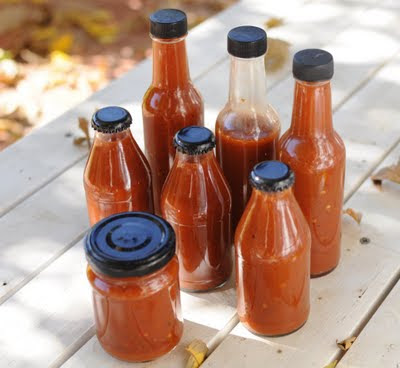
Results
I'd probably rate it about a '7/10' for heat, where tobasco sauce is 5 (although it's been some time since I had any). Although the heat lingers much longer, and builds up the more you have. A teaspoon would be enough for a nicely burning steak.
I'll have to let it sit in the bottle a while to finalise the flavours but for now I think it has a bit too much pepper which over-powers the chillies; although it's a bit hard to tell since the bite over-powers the flavour on the initial taste. Possibly more mustard, ginger, and all-spice would work too, even lime juice. Maybe a little vinegar wouldn't hurt? I think the sugar level is about right (for my palette), as is the saltiness - both of which are required to bring out the flavours. It's basically a very strong, extremely hot tomato sauce.
I don't know how it'll keep yet - the acid in the tomatoes, lime and added citric acid should hopefully be enough since I wont be finishing the litre or so I made too quickly and this is probably one sauce I can't share with friends.
And i've got more chillies and ideas to try so it might be competing for condiment time.
Apple Pie
Back to regular programming after the last rant ...
I ended up with some ageing/damaged fruit and after sitting there degrading for a week I finally pulled a finger out and made my first apple pie with the recoverable fruit. I'm not a big dessert person - I can't really remember having apple pie since I was a kid (although i'm sure I've had some here and there) - and it was never like this.
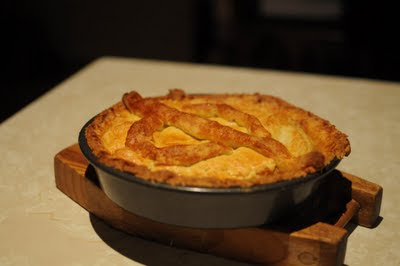 It worked out pretty well in the end; it tastes at least as good as it looks and quite possibly better. I didn't have any lemon so used citric acid with some water to keep the sliced apples from going brown - and I think that gave it a bit of extra tang. I threw in a few more spices too for good measure (vanilla, extra whole cloves, more cinnamon). Even the crust on the bottom was a bit crunchy - I tried a tip I saw on the Hairy Biker's a coupe of days ago, sprinkling the base with semolina to absorb some extra moisture. Although having never done it before I don't know if it made any difference. I used this recipe - although I had a hell of a time with the pastry. I just can't seem to get the hang of working with short pastry although it usually turns out ok.
It worked out pretty well in the end; it tastes at least as good as it looks and quite possibly better. I didn't have any lemon so used citric acid with some water to keep the sliced apples from going brown - and I think that gave it a bit of extra tang. I threw in a few more spices too for good measure (vanilla, extra whole cloves, more cinnamon). Even the crust on the bottom was a bit crunchy - I tried a tip I saw on the Hairy Biker's a coupe of days ago, sprinkling the base with semolina to absorb some extra moisture. Although having never done it before I don't know if it made any difference. I used this recipe - although I had a hell of a time with the pastry. I just can't seem to get the hang of working with short pastry although it usually turns out ok.
I've been pretty busy hacking some OpenCL stuff of late - so busy i've barely left a keyboard. More on that soon I imagine, once I get a bit of sleep and remember it is just what i've done - and if any of it is worth sharing.
Julia Gillard: Offensive Idiot
So one wonders what exactly prompted our Prime Minister to call The Greens extremists the other day, and then follow that up with the following gem yesterday:
"The Greens will never embrace Labor's delight at sharing the values of everyday Australians, in our cities, suburbs, towns and bush, who day after day, do the right thing, leading purposeful and dignified lives, driven by love of family and nation."
This is the sort of offensive wedge politics that had fuckwit little johnny rotten howard in power for a decade. Some minda of a minder has convinced her to pander to the bogan set obviously.
"The differences between Labor and the Greens take many forms but at the bottom of it are two vital ones. The Greens wrongly reject the moral imperative to a strong economy.
In this case, clearly "strong economy" is just a euphamism for "pandering to multinational and big-money interests through free trade, globalisation, and pro-business tax policies", and so on.
Not to mention fair go for all, mutual respect, and all that. Who's really being ``un-australian'' here? After-all, she's the one locking babies up behind razor wire in remote desert camps.
I'd suggest that if The Green's don't delight in sharing the values of 'everyday' Australians then it is probably the values of the particular group of 'everyday' Australians she's referring to that need to be questioned. Clearly at least 11% of the country thinks The Green's are ok enough to vote for which is a pretty big group to offend so directly (add the fact that these 11% are keeping her in power and it is clearly an idiotic thing to say).
Copyright (C) 2019 Michael Zucchi, All Rights Reserved.
Powered by gcc & me!

 Update So 6 months on, this is definitely my favourite sauce. I think it could use a bit more heat but the flavour goes with lots of things - i sometimes use it instead of butter on sandwiches, for dipping chips (it gets hot!), or to add a pleasant kick to pasta, steak, or a snag. Please comment if you give it a go ...
Update So 6 months on, this is definitely my favourite sauce. I think it could use a bit more heat but the flavour goes with lots of things - i sometimes use it instead of butter on sandwiches, for dipping chips (it gets hot!), or to add a pleasant kick to pasta, steak, or a snag. Please comment if you give it a go ...




